The main component of any electric skateboard build is the motor. You should plan your entire build around your motor(s). You have to think about how fast you want to go, and how far you plan to travel. You have to think if you would still like to have the freedom to be able to push your board or have the ability to climb hills.
- Do you want to ride off-road, trails, and parks? Yes, please
- Are you going to be commuting, weekend riding, or just out shredding the streets at night? Yes, please
- Are you going to try it at your local skatepark? Wait, what?
- Are you uphill/downhill racing? Uhhhh…..
- How about tearing up your local BMX dirt tracks? Really?
Yes, there are many options. However you spin it, any choice you make revolves around your motors.
So What Kind Of Motor Should I Buy?
I am not going to tell you which one is better. That is an argument saved for Facebook groups and builder forums. My duty is to simply inform and hopefully point you in the direction of your build.
Hub Motors
Hub Motors are motors that are exactly as you read it; they are motors that act as the hubs of the wheels (normally the rear). As they revolve, so goes the wheel. They require no other moving parts, make barely a perceptible noise, and come in quite a few different fixed speed configurations. You can even hit the skate park and ride this like a normal board if you’re supremely confident and have a bulletproof battery and ESC enclosure. Since hub motors only use sleeves as wheels, you are limited on what kind of wheels you can buy. However, it is easy to find replacement sleeves and new styles are coming out all the time. A unique feature of hub motors besides their silence is the ability to still kick-push your board normally if your batteries die. And depending on your motor configuration, you may even be able to recharge the batteries this way.
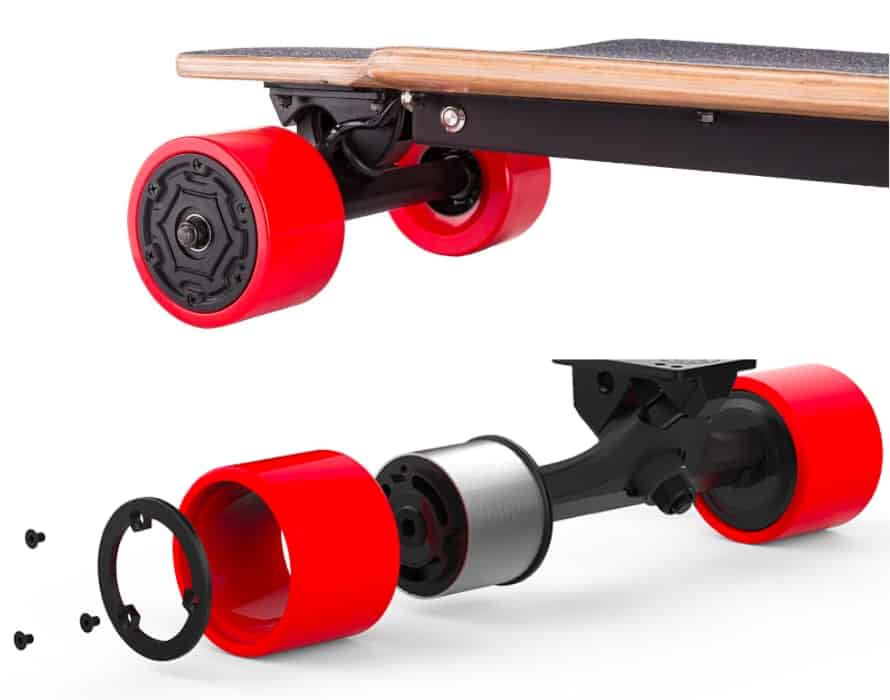
Belt Drive Motors
Belt drive motors feature a brushless motor(s) with a pulley on it connecting via a belt to a larger pulley on the wheel. Belt drives offer you multiple swappable options for gear ratio, high torque, and speed. These can be great motors if you live in hilly country or plan on mixed on and off-road use for your build. Some DIY all-terrain riders convert their belt drives to chain-driven for even more durability. You can run them as a single motor or dual-motor configuration. They also tend to have a lot of moving parts that can require tweaking and may vibrate loose or move out of square. Depending on your setup, the torque these little monster motors put out may require adjustment to motor mounts, belts, and motors during and after a hard ride. But when dialed, the power will put a smile on your face. Truly the best part about the belt drives besides the high torque curve is the fact that you can adapt any system for use on virtually any skateboard truck, any skateboard wheel, or all-terrain wheels you can fit a pulley on. The online community is huge and there is a lot of support if you need help and no crazy questions are unwelcome.

Direct Drive
Direct drive offers the best of both hub and belt drive in that they have the high torque and high speed of belt-driven motors with the direct input of hub motors, so there are no belts, mounts, or pulleys. The acceleration is 100% tunable just like the belt drive with all that power going straight to the wheels. On top of all that direct power, these motors tend to dissipate heat quickly so running higher speeds for longer periods makes these the ideal choice for the uphill racer. With these motors, you have the perfect cocktail of ease of use, quick acceleration, and well-balanced power control. Best of all, you can use any skate wheel you can fit an adapter on, including all-terrain wheels and push kick when you were too dumb to charge your battery at the last stop. Of course, there is no perfect motor for all situations, and direct drive has its flaws. Direct drive motors are BIG. Their relative size puts them real low to the ground and subject to damage from debris. Their cans are not bulletproof, and even a small rock can do damage. Riders using pneumatic wheels on street and off-road would benefit greatly from direct drive. For the brave soul who wants to feel the power and run low and fast on urethane street wheels, you will want to start learning how to carve and weave quickly.
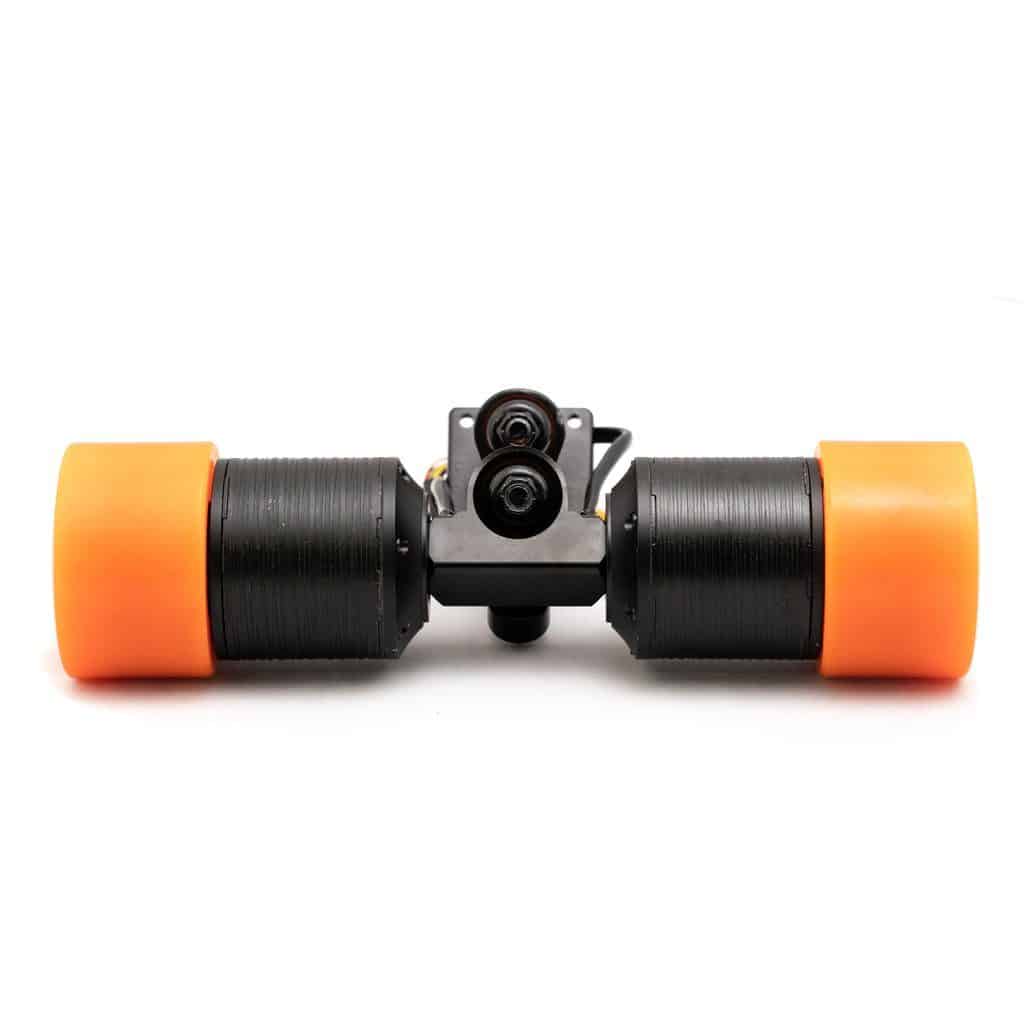
Gear Drive
The gear drive may seem new, but DIY “gearheads” have been experimenting with gear-driven systems for years. For the most part, gear drive systems are small sophisticated close fixed gear systems that feature the best of all the systems above. You can change your wheels whenever you want, no belts, with the torque of belt drive all in a compact system with room to tear up both mountains and the urban landscape. Most of these systems are incredibly responsive and ridiculously compact. Some incredible DIY all-terrain race rigs even feature changeable gearing, though, for the most part, you are going to find fixed gear systems are the norm. The biggest drawback to this system is the gear noise which can be deafening for the most sensitive (for the rest of us it’s just annoying), the complexity, and the expense. These can be very expensive integrated drive trains for a lot of DIY builders to take on. However, the expense is well worth it if you can afford it. If you are a serious off-road racer in desperate search of a high speed sealed system, this may be the motor/drive train combo for you.

Which Features shall my Motor have?
Before you can eSk8 you need to decide what kind of electric skateboard you want to build. Do you live in the city and don’t hit the hills or the trails that often? You can build an inexpensive but quick hub motor board or a single belt drive with a light battery and put it on an old school kick tailboard, or retro pintail deck, and style your way through the urban wasteland. Do you feel frisky and like to get muddy? Then a monster dual-motor belt drive with 8 or 9 inch knobby AT wheels and pneumatic tires paired with suspension trucks on a Trampa style deck with bindings is gonna give you a real good time. DO you have the need for speed? A long drop thru downhill board paired with direct drive and a 12s4p battery will push the eyes in the back of your head. Now that you have your dream build in mind, put it down on paper. Write down which style of board you want. Visit a website like Skateshred.com, Zumiez.com, or better yet, pop into your local skate shop and check out what they have to offer. Write down the style of a skateboard you want to buy. This will be the start of your parts list.
A special note about this, skateboards have a wheelbase size and that tells you how much space in the middle of the board you have to put a battery, ESC enclosures, motors, disco lights, etc. It helps to know how much space you plan on using for these items before you hit the Pay Now button.
How fast do you really want to go?
This needs to be said before we move any further. Even a cruising speed of 15mph is your fastest running speed.
A good rule of thumb is to base your top speed on your skateboarding experience. Have you spent years skateboarding, snowboarding, or surfing, wiping out, and getting back up? Riding any board is probably instinctual for you so you already have a good grasp on control, better still; you have a feel for when things get out of control. Grab a direct drive or dual belt setup, max out the power, and put it down.

If you have never been on a skateboard before, it would make more sense to stick with a slower hub motor setup where you can work your way up to the higher speeds while working on skateboarding fundamentals like carving and control. Better yet start with a single belt drive setup, and then when comfortable with the speed, you can add another belt drive setup easily and double your speed.
Hey Cool Guy! You know who you are. The guy who thinks he’s too cool to wear a helmet because he used to be punk rock back in the day. Or the hipster who plans to spend as much time mall carrying his board as he does riding it and doesn’t want a helmet to ruin his hair. These skateboards CAN KILL you. Even a crash at 15mph with no helmet can make you a vegetable. I have been to a friend’s funeral after a downhill ride gone badly. Don’t be a statistic, find a helmet, and wear it!
Do I Really Need to Know About Gear Ratios for my Build?
The short answer is No. As I mentioned earlier that hub and direct drive motors do not use gears or belts to work. So you can bolt and go. Belt driven motors have pulleys that require you to eventually learn about gear ratios if you want to make quick mechanical improvements to your launch or top speed. It especially helps when trying to figure which belts you will need to buy for your build. That is the biggest problem with belt drive builds is finding belts that match the mounts and motors of your build. There are plenty of apps for your IOS or Android compatible device (like esk8calc) that will help you calculate those ratios for you until you have the setups you like.
A good standard starting pulley setup for a street setup is a 36 tooth gear on the wheel and a 15 tooth gear on the motor.
You can pick a wider pulley as well, which will give you a wider belt and more positive power but may require you to alter the trucks to make them fit.
Gear-driven is self-explanatory and would require more knowledge than I have in regards to setting those up. Suffice it to say, you should have at least a working understanding of gear rations for gear-driven setups.
Putting Power to the Motors
No matter what style of motor you go with, you are going to need an ESC to power it. An ESC, or electronic speed controller is the brains of your electric skateboard. It reads the signal from your remote control, takes power from the battery, and applies it to your motor(s). For eSk8 there are generally two common ESCs.
Non-Programmable
This ESC has preprogrammed onboard data that tells your motors how they should operate. These have no programming, are 100% plug and play, and generally come with their remote controls. These are most common on sites like eBay, Amazon, or mboards.com. You have to know what the max voltage these kinds of ESCs can handle before matching to your battery and motors or you could have a short or even a fire.

Programmable
Connect your phone or laptop and this ESC is fully programmable. The most popular of these is known as a VESC (Vedder Electronic Speed Control), named after Benjamin Vedder, a robotic engineer who developed the open-source software program used to customize all kinds of electronic motors. This software app allows you to easily dial in and program your ESC. VESCs are more expensive due to their programmable nature but are by far the most stable ESCs you can buy. You can program battery style and motor style right in the ESC, so one ESC can manage many different motor styles and handle many different voltages.

The proper ESC can make or break your build so choose carefully.
Good programmable ESCs to check out…. Flipsky FESC 4 & 6, Focbox, Unity, mBoards, Hobbyking, Maytech
Battery Choice
Batteries are what make your motors go. A lot of sites offer batteries, but how do you know which ones to invest in? Ah, well, this goes back to what you plan to do with your eskate.
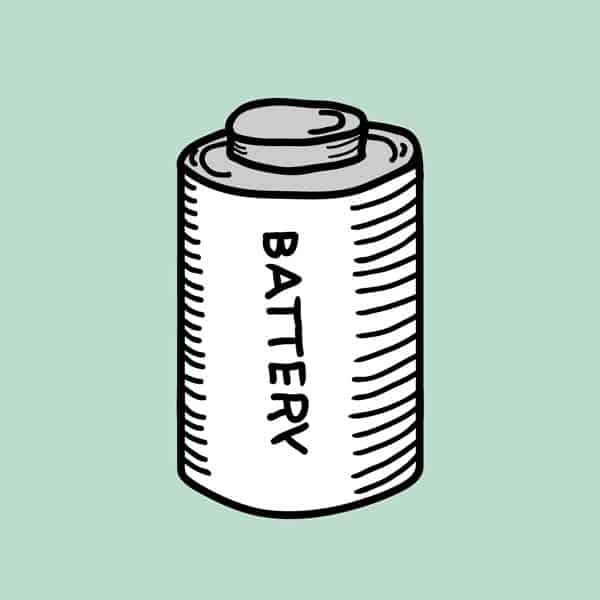
Series (S) and Parallel (P) (eg 10s1p, 12s2p) – Are the configuration for how the battery cells are connected.
I have a general rule of thumb I follow:
- 6s batteries: 15 – 20 mph, Short commutes, mid-range speeds on flat ground.
- 10s batteries: Mid to high speeds 20 – 25mph and middle of the ground in terms of range, not too hard on ESCs.
- 12s batteries: Best overall speed 25 – 30+mph with mid to high range. Can be too much for some non-programmable ESCs or the wrong VESC.
What about the P (Parallel)? Well I have noticed the parallel rating in eskate batteries tends to pertain more to the range. Since you can mix the two you can have any of the above and any of the below.
- 2p batteries: About 10 – 12mile range
- 3p batteries: About 12 – 15mile range
- 4p batteries: About 15 – 20mile range
These are general figures. There are a lot of other variables to consider. I just wanted to give you a general rule of thumb to help in planning your build.
Great places to buy a reliable battery and charger. MBoards.com, DIYelectricskateboard.com, Hobbyking.com.
For more info check out our Guide on Electric Skateboard Batteries.
Wheel Choice
Well, we can break it down like this:
If you are planning on spending most, if not all of your time in an urban environment, and the only trails you are going to see are occasionally hitting the grass to avoid dog poop or angry jogger, then you will want to ride Urethane street wheels or smaller AT wheels with street tires. Both are going to give you a real thrill with the smaller AT wheels safer for newer riders. If you are going to be invading your local BMX track and jumping doubles or tearing up your local forest trails, then the big gnarly knobby AT wheels are the only way to go. For more info check out our Electric Skateboard Wheel Guide.
Some more things you should know about Belt Drive Builds…
Motor mounts
Mount and truck combos are the best as they most likely were designed to be used together and by design will be much stronger. Look for mount supports if they are offered for the brand of mounts your choose to use. There are generally two diameters to belt-drive motors, 50mm and 63mm. Your motor mounts will fit one or the other depending on the first number in your motor dimensions. Make sure you know which motor you are buying before buying your motor mounts. Brands to note when buying motor mounts….Evolve Skateboards, MBoards, Boardnamics, DIYE, Torqueboards, Flipsky

Pulleys and belts:
Remember that these are DIY builds, and as such, there always tends to be a place that gets little attention, yet can hold up an entire build. Enter the drive belt. It can take weeks to locate the properly sized belts. Whenever you buy a pulley set online it’s a crapshoot on whether the belt they ship will fit your setup. Websites to take note of for Belts……vbeltguys.com, evolvesakteboardusa.com, diyelectricskateboard.com, or mboards.com. VBelt Guys even have a calculator on their site to help you find belts if you get lost.
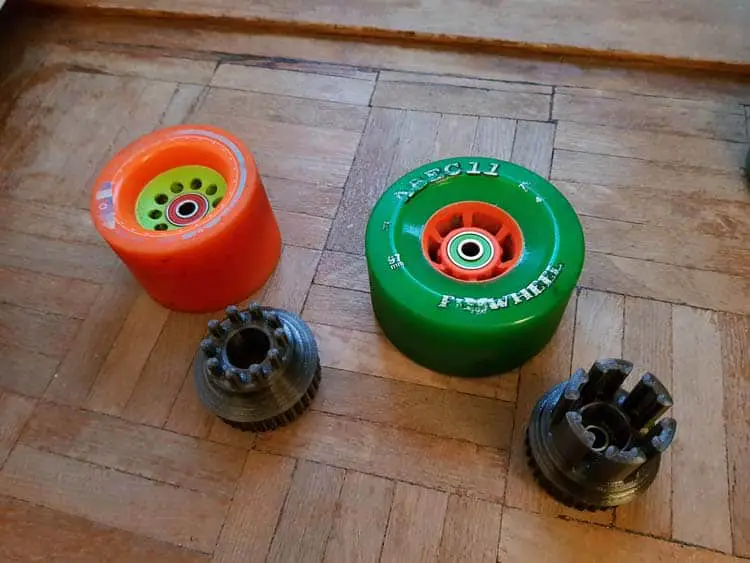
Get to know the Vocabulary of Electric Motors
- Model Dimensions (4-digit number): The 4 digits of the motor denote the size of the motor. For example, the motor on a 6384 motor means that it’s 63mm in diameter and 84mm in length.
- KV Rating (RPM/ Volt): The Kv rating of a brushless motor is the ratio of the motor’s unloaded rpm to the peak voltage on the wires connected to the coils. Knowing the Kv rating of a motor will help you determine how fast that motor will rotate when a given voltage is applied to it. A tip: lower Kv rating, higher torque. Higher Kv rating, higher speed. Good middle ground Kv 190Kv.
- Max Power (Watts) : WattHours(Wh = Ah * max voltage) = Size of the battery. The power that a battery can output in one hour. WattHours is the total battery size and an even better indicator of range. The general rule of thumb is WattHours/ 10km=Range
- Max Current (Amps): The current that a battery can give. This affects the top speed.
- Continuous discharge current = The ampere that the battery can provide continuously without overheating. Most electric skateboards need their batteries to be at least 30A continuous.
- Ampere Hours: The charge that a battery holds. This affects the range. (Number of Ampere that a battery can put out if it was to fully discharge in one hour, hence Ampere/Hour) 1000mAH = 1Ah
- Max Volts (V): The torque that a board gives. Also improves the efficiency of the battery hence range. Industry-standard = 36V. If the voltage is too low, the board will not have enough torque. If the voltage is too high, the motor/ ESC can not handle it.
- Max Torque (Nm): Torque in short is the twisting force or the force that produces a rotary motion or rotational force.
- Motor Resistance (Ohms): The ohm is defined as an electrical resistance between two points of a conductor when a constant potential difference of one volt, applied to these points, produces in the conductor a current of one ampere, the conductor not being the seat of any electromotive force.
- Unsensored & Sensored motor: Sensored motor allows the ESC to detect the position of the motor at all times, which translates into a smoother start-up. Unsensored motor, on the other hand, often is jerky when starting from a standstill and often requires a kick push to have a smooth start.
- Shaft Diameter: The diameter of the output shaft on the brushless motor. Generally in electric skateboarding, there are two shaft sizes 8mm and 10mm. 8mm is used on most electric skateboards while 10mm is normally reserved for the larger more aggressive all-terrain eSk8 boards.
Most Popular DIY Motor Vendors
TorqueBoard : DIYelectricskateboard.com
Flipsky: flipsky.net
Maytech: maytech.cn
MBoards: MBoards.com
Hobby King: hobbyking.com
Complete Eskate DIY Kits
Build Kit Boards : Check out the Duo and Tayto Complete Kits. Full kits including decks!

Torqueboards offers its Dual Motor Mechanical Kit. The only anodized mount kits in the industry.
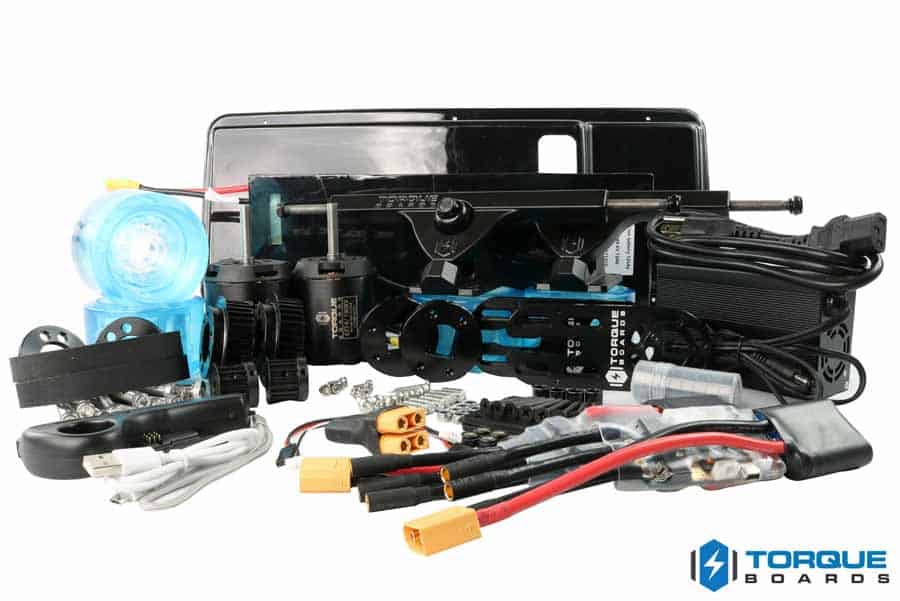
MBoards: Recently MBoards began offering an online kit builder. Simply go to their website and start customizing your kit.

The Revel Kit: A complete bolt-on Direct Drive kit capable of turning ANY existing skateboard into a full-blown electric skateboard the Revel Kit does what a lot of eSk8 companies have tried to do. You have to check these guys out at revelboards.com
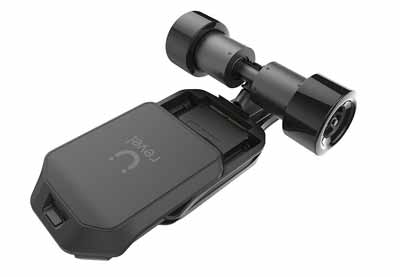
Final Thoughts
Have I got you excited yet? Are you READY to build an Electric Skateboard? You have drooled over the cool youtube videos of guys tearing up the streets and trails, you have lurked in eSk8 groups, and you have browsed the parts companies. You have drawn pictures of your eskateboard; you have already named your eSk8 company, right? YOU ARE READY!!!! So what’s left? Oh yeah, get out there and build your dream board!



Do you have a electric skate wheel motor that will carry 180 pounds. What is the price of the kit?
I need the motor to be controlled by a twist throttle, reverse switch and e brake. Do you have it?
Kenneth
[email protected]